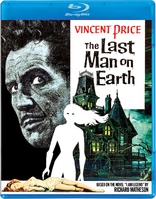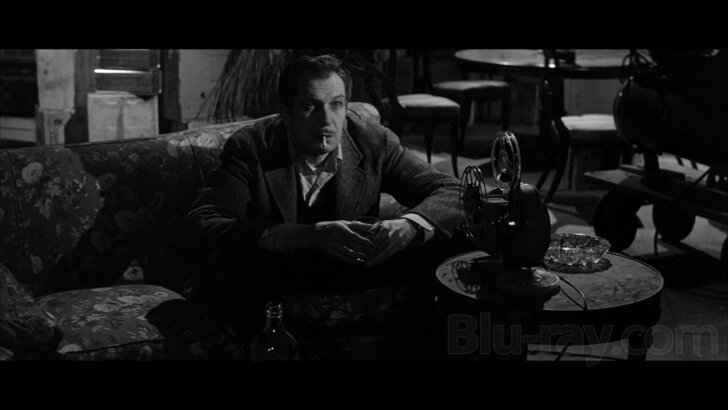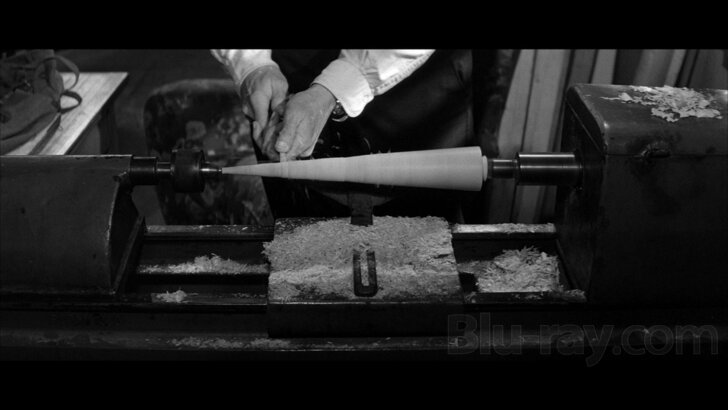The Last Man on Earth Blu-ray Movie
HomeThe Last Man on Earth Blu-ray Movie 
Kino Lorber | 1964 | 86 min | Not rated | Aug 31, 2021
Movie rating
7 | / 10 |
Blu-ray rating
| Users | 4.0 | |
| Reviewer | 4.0 | |
| Overall | 4.0 |
Overview
The Last Man on Earth (1964)
The sole survivor of a lethal virus that transforms all others into vampire-like zombies. He fights them nightly, until, desperately lonely and at the end of his rope, he makes a startling discovery!
Starring: Vincent Price, Franca Bettoia, Emma Danieli, Giacomo Rossi Stuart, Umberto RahoDirector: Sidney Salkow
| Horror | Uncertain |
| Sci-Fi | Uncertain |
| Drama | Uncertain |
Specifications
Video
Video codec: MPEG-4 AVC
Video resolution: 1080p
Aspect ratio: 2.34:1
Original aspect ratio: 2.35:1
Audio
English: DTS-HD Master Audio 2.0
Subtitles
English SDH
Discs
Blu-ray Disc
Single disc (1 BD)
Packaging
Slipcover in original pressing
Playback
Region A (locked)
Review
Rating summary
| Movie | 4.0 | |
| Video | 4.0 | |
| Audio | 5.0 | |
| Extras | 2.0 | |
| Overall | 4.0 |
The Last Man on Earth Blu-ray Movie Review
Reviewed by Dr. Svet Atanasov April 21, 2022Sidney Salkow's "The Last Man on Earth" (1964) arrives on Blu-ray courtesy of Kino Lorber. The supplemental features on the disc include new audio commentary by critic Richard Harland Smith; archival program with Richard Matheson; alternate ending; and vintage promotional materials for the film. In English, with optional English SDH subtitles for the main feature. Region-A "locked".

Is Sidney Salkowís The Last Man on Earth the best cinematic adaptation of Richard Mathesonís popular novel? There are plenty of people that believe that it is, but I am not convinced that this is true and I would like to tell you why.
First, letís identify its main competitor. It is Boris Sagalís The Omega Man, which was released seven years after it and shot in color. What about Francis Lawrenceís I Am Legend? I am sorry, but I donít think that this film is good enough to bring into this discussion because there are too many special effects in it that embellish Mathesonís story in ways that simply arenít right for it. So, letís compare what works in The Last Man on Earth and The Omega Man and point out what doesnít and why.
Both films emphasize minimalism in ways that feel right. In Salkowís film, Vincent Price plays scientist Dr. Robert Morgan who has survived a deadly plague that has wiped out the human race. He is quite possibly the last man on earth, but isnít alone. At night, he barricades in his home while zombie-like creatures attempt to break in and kill him. They do it over and over again, but their presence isnít what troubles his mind. It is the memories of the early days of the plague and the exact moment when he lost his family that he has a difficult time keeping at bay. Each night, these memories flood his mind and make him feel miserable in a way he never imagined possible. The minimalistic visuals throughout Salkowís film are so good that they very quickly create the impression that Dr. Morgan is a prisoner in a very, very big cell. Since the film was shot in black-and-white, they are appropriately depressing as well.
In Sagalís film, Charlton Heston is Dr. Robert Neville and he seems to be the only human survivor of an apocalyptic war. There are other living creatures around him that resemble people, but they are actually mutants that have learned to adapt to their Ďnewí environment. These mutants see Dr. Neville as a target that needs to be eradicated because it was his kind that doomed them to live as they do. The film was shot in color and despite emphasizing minimalism in much the same way Salkowís film does has a very different ambience.
What makes it awfully difficult and ultimately impossible to declare a better film is the fact that both see the post-apocalyptic environment in which their characters exist from completely different angles. On top of this, both take some substantial liberties with the original material from Mathesonís novel. For example, Price undergoes a pretty dramatic transformation at the end of which he emerges a defeated man willing to accept his fate. But is it because he is overpowered by his memories of the past and gloominess of the present, or because at a certain point he realizes that it is his kind that is doomed to perish? In Mathesonís novel the survivor is in a dark and depressing place as well, but he isnít a defeated man.
Heston gives his survivor a very, very different personality, which is that of a fighter determined to defend the integrity of his kind until the very end. Also, there is a very particular and unmissable machismo his character exudes, which seems perfect for the environment in which he is left to exist. Simply put, the film can't function properly without it.
Salkowís visualization of the post-apocalyptic world will resonate better with viewers who imagine the place as something of a desolated dead-end street. Once you enter it, it is only a matter of time before you reach its depressing end, so the more minimalistic it is, the more accurate it seems. Sagalís visualization of the post-apocalyptic world is more vibrant and exciting, a bit like an exotic playground where anything is possible. Could this be the more authentic of the two visualizations? No. In this playground the survivor simply has the option of using a few alternative ways to reach the same depressing end.
The Last Man on Earth Blu-ray Movie, Video Quality 

Presented in an aspect ratio of 2.34:1, encoded with MPEG-4 AVC and granted a 1080p transfer, The Last Man on Earth arrives on Blu-ray courtesy of Kino Lorber.
The release is sourced from an older but good organic master that was supplied by MGM. The overwhelming majority of the visuals boast very nice delineation, clarity, and sharpness. Depth is consistently pleasing as well, though there are a few sequences with minor fluctuations, usually before or after transitions. There are no traces of problematic digital work. Predictably, grain exposure is ranges from good to very good. Yes, there is some room for improvement, but even if this film is restored in 4K, the overall quality of the grain exposure would be very similar. The master is very nicely graded. The blacks are lush but never appear boosted, while the grays and whites are convincingly balanced. As a result, plenty of the darker footage reveals strong shadow definition. Image stability is good, but a few times I noticed mild shakiness. Also, I spotted quite a few white specks, scratches, and blemishes, so there is definitely room for some cosmetic improvements. (Note: This is a Region-A "locked" Blu-ray release. Therefore, you must have a native Region-A or Region-Free player in order to access its content).
The Last Man on Earth Blu-ray Movie, Audio Quality 

There is only one standard audio track on this Blu-ray release: English DTS-HD Master Audio 2.0. Optional English SDH subtitles are provided for the main feature. When turned on, they appear inside the image frame.
The audio is clear and stable. Balance is good as well. Dynamic intensity is quite limited, but this is to be expected given the nature of the production. In the upper register is healthy, but I did notice a couple of minor pops. There are no distortions or audio dropouts to report in our review.
The Last Man on Earth Blu-ray Movie, Special Features and Extras 

- Commentary - this exclusive new audio commentary was recorded by critic Richard Harland Smith.
- Trailers From Hell - presented here is an archival episode of Trailers From Hell with Joe Dante. In English, not subtitle. (3 min).
- Alternate Ending - in English, not subtitled. (1 min).
- TV Spots - a couple of vintage TV spots for The Last Man on Earth. In English, not subtitled. (1 min).
- Trailers - two archival trailers for The Last Man on Earth.
1. Italian trailer. (4 min).
2. North American trailer. (2 min).
- Richard Matheson: Storyteller - in this archival program, Richard Matheson discusses the original material that inspired The Last Man on Earth and some of the key themes in it. In English, not subtitled. (7 min).
The Last Man on Earth Blu-ray Movie, Overall Score and Recommendation 

I did a double bill a few nights ago that also included What's So Bad About Feeling Good? and have to say that there are important lessons in these films that should not be ignored. Obviously, they have very different styles and tones, but if you ignore what they do to entertain, you will easily realize that the scenarios they warn of are not exactly unrealistic. In fact, virtually everything that is depicted and satirized in What's So Bad About Feeling Good? is now a fact of life. I don't think that The Last Man on Earth is a very accurate cinematic adaptation of Richard Matheson's novel, but neither is its greatest competitor, The Omega Man, and yet they are both very good films. Kino Lorber's release is sourced from an older but solid organic master that was supplied by MGM. HIGHLY RECOMMENDED.
Other editions
The Last Man on Earth: Other Editions
Similar titles
Similar titles you might also like

The Comedy of Terrors
1963

Night of the Living Dead 4K
Theatrical (UHD/BD) and Workprint (BD) versions
1968

The Masque of the Red Death
Remastered | Extended Cut
1964

Patient Zero
2018

Stake Land
2010

Day of the Dead
Collector's Edition
1985

The Tomb of Ligeia
1964

Rabid
2019

The Cured
2017

Viral
2016

The Strain: The Complete First Season
2014

Return of the Fly
1959

The Girl with All the Gifts
2016

Dawn of the Dead
1978

Lifeforce
1985

Jackals
2016

Rabid 4K
Collector's Edition
1977

The First Omen
2024

Primal Rage 4K
Rage - Furia primitiva
1988

Cabin Fever: Patient Zero
2014

